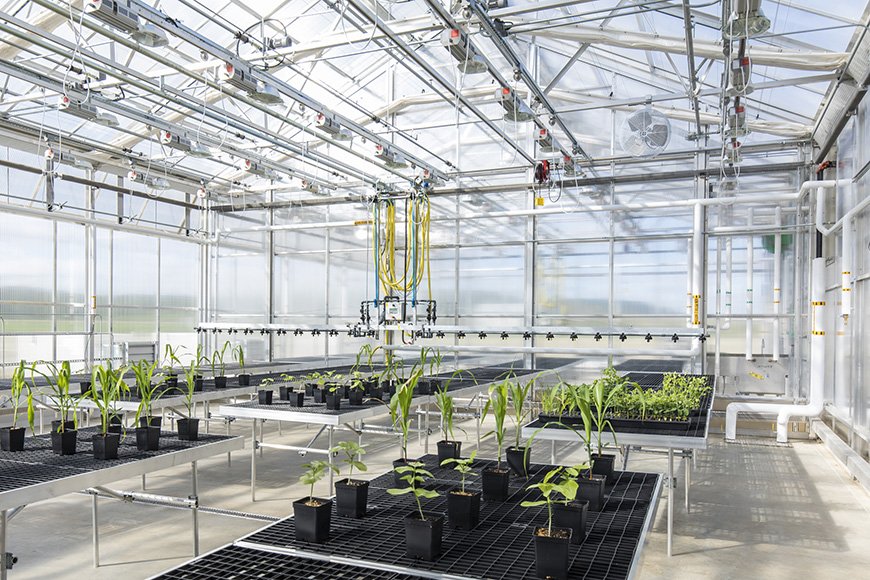|
4 new findings from the WinField United Innovation Center in River Falls, Wisconsin
USA
December 28, 2023

The WinField United Innovation Center in River Falls, Wisconsin, is our epicenter for research and development. The 55,000-square-foot hub contains controlled environments, chemistry labs, a seed care and plant performance lab, a spray analysis system, a 3D image-based lab and more.
These facilities allow us to continuously test the efficacy, stability and performance of our products as well as provide some of the industry’s leading data and the next products in agriculture. 2023 has been an exciting year for Innovation Center research with these four new projects forging new discoveries.
1. Leaf Herbicide Residue Research
Strong field research methods have been a key component of our crop protection testing for decades, but now we’ve taken it to another level. Our new leaf herbicide residue research protocol gives us a more accurate depiction of the amount of product left on the leaf surface (residue) after an application, unlocking better insights into how WinField United adjuvants influence tissue uptake. If the product is left on the leaf surface, it is not in the plant and therefore will not provide the expected activity, wasting the grower’s investment.
So far, we have looked at dicamba, 2,4-D and glufosinate. This same protocol can be used to measure foliar nutrient residues as well, so we can analyze products like MAX-IN® micronutrients in the future.
Key Finding: Enlist One® herbicide residues were reduced, indicating greater uptake, when applied with Class Act® NG® adjuvant, which contains ammonium sulfate (AMS) plus surfactant.1
2. Competitive Adjuvant Data Collection
Class Act NG and InterLock® adjuvant have been leaders in the AMS and drift reduction categories for many years. But we wanted to challenge ourselves and be certain in our understanding of how these flagship adjuvants stand up against the competition. So, we designed a research protocol to help us do that. This research project analyzes products that are compared to InterLock or Class Act NG in their marketing and positioning.
For InterLock, we conducted testing in our wind tunnel with various competitive products, looking at different nozzles and tank mixes to mimic various real-world applications.
Key Finding: InterLock is still an industry standard for reducing driftable fines across different nozzles and tank mixes. Its universal usage is what makes it such a leading product.
For Class Act NG, we took competitive products and sprayed different herbicides – glyphosate and glufosinate – on several different weeds e.g., kochia and Palmer amaranth. Then, we evaluated their impact.
Key Finding: Class Act NG is still an industry standard for AMS and surfactant. The consistency it provides across different herbicides and weeds is unparalleled.
3. 3D Plant Imaging
An exciting new addition to the technology lineup at the Innovation Center is our automated 3D plant imaging system Phenospex. It is a set of paired scanners that move across our greenhouse and captures plant characteristics in 3D.
This allows us to look at how products influenced plant growth and health under different growing conditions. The scanners can image 240 plants in 60 minutes and non-destructively measure each plant. This drastically saves time and resources as the system can collect nearly 5,000 measurements each time it moves across the greenhouse.
The Phenospex system can capture many morphological measurements such as height, biomass, leaf area and plant health indicators like NDVI, which measures greenness. Our system is also paired with a controlled irrigation system we can use to water plants to the nearest milliliter, allowing us to create different water-stress environments. With the precision of this system, we can see how different crop protection and performance products influence a plant’s growth and development over time.
Key Finding: MasterLock® adjuvant improved fungicide efficacy and plant health (NDVI) in oat plants in the presence of crown rust.2 The new system allowed us to precisely quantify this impact in a way we haven’t been able to before.
4. Spray Tech 2 Wind Tunnel
In the spring of 2021, we completed construction on Spray Tech 2, and over the past two years, we have been collecting data and insights from it. This wind tunnel doesn’t just study droplets in the lab, it actually mimics field conditions.
In traditional wind tunnels, you can measure nozzles by using lasers, but you can only measure one nozzle at a time. Spray Tech 2 is much larger and with it, we can look at entire boom sections to gain more field-level insights.
The wind tunnel has two sections. In the bottom, we can put entire boom section in to measure field-scale situations. In the top, we have high-speed settings we can use to measure aerial application scenarios.
Key Finding: Drift reduction agents (DRA), which are legally required in dicamba applications, do indeed reduce drift.
There are many new discoveries ahead for the Innovation Center in 2024. For more information on the research conducted at the facility and the findings that come from it, contact your WinField United retailer.
1 Trial conducted at the Innovation Center in River Falls, Wis., in 2023. 16.29 μg/mL of Enlist One was applied to the leaf surface. Treatment solutions were applied with a glass syringe at a spray volume of 15 gal/A.
2 Trial conducted in the Controlled Environments at the Innovation Center in River Falls, Wis., in 2023. Tetraban® fungicide was used, applied at a rate of 3 fl. oz./A.
All photos are either the property of WinField United or used with permission.
More news from: WinField United
Website: http://www.winfieldunited.com/ Published: January 11, 2024 |